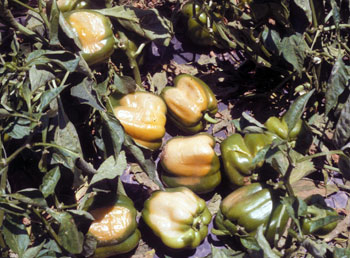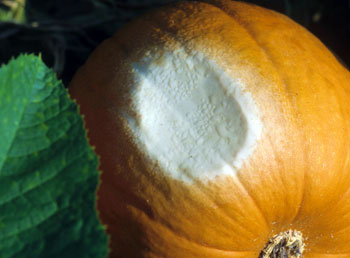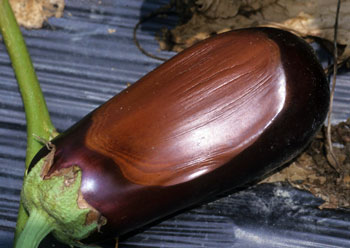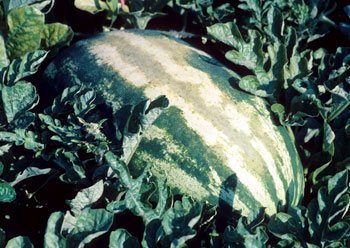Preventing sunscald in vegetables
Sunscald happens to almost any fruit and vegetable and can be a serious problem before and after harvest with results just as economically devastating as disease or insect damage.
Sunscald (Photos 1-4) generally occurs when any plant part developing in lower light is suddenly exposed to higher light levels. Had that plant part always been exposed to full sun, chances are it would not have developed sunscald. The condition for plants is similar to what our skin experiences. If our skin is gradually exposed to increasing sun light, it adjusts. However, if it is suddenly exposed to bright sun for even a relatively short period, it will burn. This knowledge helps growers take steps to minimizing damage.


Photos 1-2. Sunscald symptoms on peppers (left) and pumpkin (right).
Photo credits: Gerald Holmes, Valent USDA Corportation, Bugwood.org


Photos 3-4. Sunscald symptoms on eggplant (left) and watermelon (right).
Photo credits: Gerald Holmes, Valent USDA Corportation, Bugwood.org
One of the first steps is to develop and maintain a good leaf canopy providing the necessary cover for fruit. A good leaf canopy is obtained through properly balancing plant growth through pruning, fertilization, irrigation and pest control. Powdery mildew is a serious disease for pumpkins and fall squash. If left uncontrolled, it can lead to significant defoliation by late August. Preventing sunscald in pumpkins and fall squash starts with selecting cultivars with some level of powdery mildew tolerance and complimenting that tolerance with timely fungicide applications during periods of high disease pressure. Proper disease control measures can be found in Michigan State University Extension Bulletin 0312, “2014 Insect, Disease and Nematode Control for Commercial Vegetables”.
Another step in reducing sunscald is training workers on proper harvesting techniques. This is especially true in crops like summer squash, zucchini and peppers. The highest sunscald incidence for these crops often occurs after harvest. If workers are not careful when they harvest summer squash and zucchini, they can cut leaves when they cut fruit from the plant, exposing remaining fruit. Bell peppers often have several fruit at various stages crowded on the same plant. When the most mature fruit is harvested, it can expose remaining fruit. Protection for peppers starts with good plant development to get a good leaf cover, but workers also need educating on how to be careful not to break off branches or bend plants over at harvest.
Sunscald can also occur after harvest, especially on dark-fruited vegetables such as eggplant, cucumbers, watermelon and squash. Once off the plant, fruit should be taken to the packing shed as soon as possible. If it can’t be packed quickly, it should be protected by placing it under shade. I have seen serious sunscald develop on eggplant because it was left in the sun too long after harvest. It was actually possible to feel by hand the increased temperature on the exposed side of the fruit. Sunscald symptoms occurring after harvest develop after packing, only to be observed later in the distribution chain. This can result in getting a bill for disposal rather than a check for your product.



 Print
Print Email
Email




